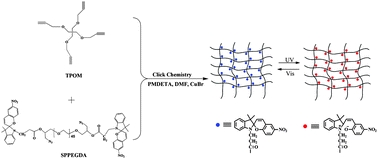Well-defined and biocompatible hydrogels with toughening and reversible photoresponsive properties†
Abstract
In the present study, novel hydrogels with extremely high strength, reversible photoresponsive and excellent biocompatible properties were prepared. The functional hydrogels were synthesized from a well-defined poly (ethylene glycol) polymer with spiropyran groups at a given position (PEG-SP) via a Cu(I)-catalyst Azide-Alkyne Cycloaddition (CuAAC) reaction. The molecular structures of the sequential intermediates for PEG-SP hydrogel preparation were verified by 1HNMR and FT-IR. The mechanical property, swelling ratio, compression strength, surface hydrophilicity, and biocompatibility of the resulting hydrogel were characterized. Since spiropyran is pivotal to the switch in hydrophilicity on the hydrogel surface, the swelling ratio of PEG-SP hydrogel under Vis irradiation has a major decrease (155%). Before and after UV light irradiation, the contact angle of the hydrogel has a change of 13.8°. The photoresponsive property of this hydrogel was thus demonstrated, and such a property was also shown to be reversible. The well-defined PEG-SP hydrogel can also sustain a compressive stress of 49.8 MPa without any macro- or micro-damage, indicating its outstanding mechanical performance. Furthermore, it possessed excellent biocompatibility as demonstrated by its performance in an in vivo porcine subcutaneous implantation environment. No inflammation was observed and it got along well with the adjacent tissue. The above features indicate that PEG-SP hydrogels are promising as an implantable matrix for potential applications in biomaterial.


 Please wait while we load your content...
Please wait while we load your content...